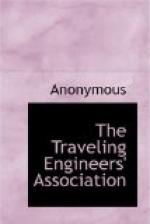21. Q. How should rod brasses be keyed?
A. If properly fitted they should be keyed brass to brass; if not so fitted, they should be keyed on the large part of the pin so they will be free enough to run without heating and snug enough to run without pounding. Do not key them so tight at either end as to prevent the lateral motion of the brass on the pins.
22. Q. How should an engine be placed for the purpose of keying the rod brasses?
A. For the main rod, place the engine on the quarter or the top forward eighth, whichever place gives the largest diameter of the pin to key the brass against. After keying up, test by moving the wheel to another position and see if brasses are free on the pin. For the side or parallel rods, always place the engine on the center for the side that is to be keyed.
23. Q. How should the side rods on a mogul or consolidation locomotive be keyed?
A. Place the engine on the center on that side, key up the brass on the main pin first, work each way toward the ends of the rods, being careful to keep them the proper length so they do not bind when passing either center. Be sure that wedges are properly set up before keying the side rods.
24. Q. What is the necessity for keeping the brasses keyed up properly?
A. If too tight, they will surely run hot; if too loose, they will pound and injure the brasses as well as endanger the safety of the straps and rod bolts. Very loose brasses can pound enough to get hot.
25. Q. What is meant by an engine out of tram? Out of quarter?
A. When corresponding wheels on opposite sides of the engine on different axes are not spaced equally apart; where the axle of any wheel is not at a right angle to the center line from front to rear of engine, so they do not run square on the rails, or where the space between the axle centers on opposite sides is not equal. This is sometimes indicated by unequal flange wear and should be reported at once. Wheels are out of quarter when the crank pin in one wheel is not exactly 90 degrees or one quarter of a turn from the pin in the wheels on the other end of the same axle. This is usually caused by slipping the engine with sand on one rail only and the condition of engine should be reported at once.
26. Q. Describe a piston valve.
A. A piston valve is a cylindrical spool-shaped valve constructed with packing rings much the same as the steam piston that moves through the cylinder, except that a piston valve is double or composed of two pistons connected by center rod or spool working in a bushing of equal diameter. Steam and exhaust ports are cut through this bushing; steam ports to the cylinder and exhaust port to the exhaust pipe. There is also a steam port for live steam from the boiler. As the pressure on this valve is equal in both directions it is practically balanced.
27. Q. What is a balanced slide valve? How is it balanced, and why? For what purpose is the hole drilled through the top of the valve?




